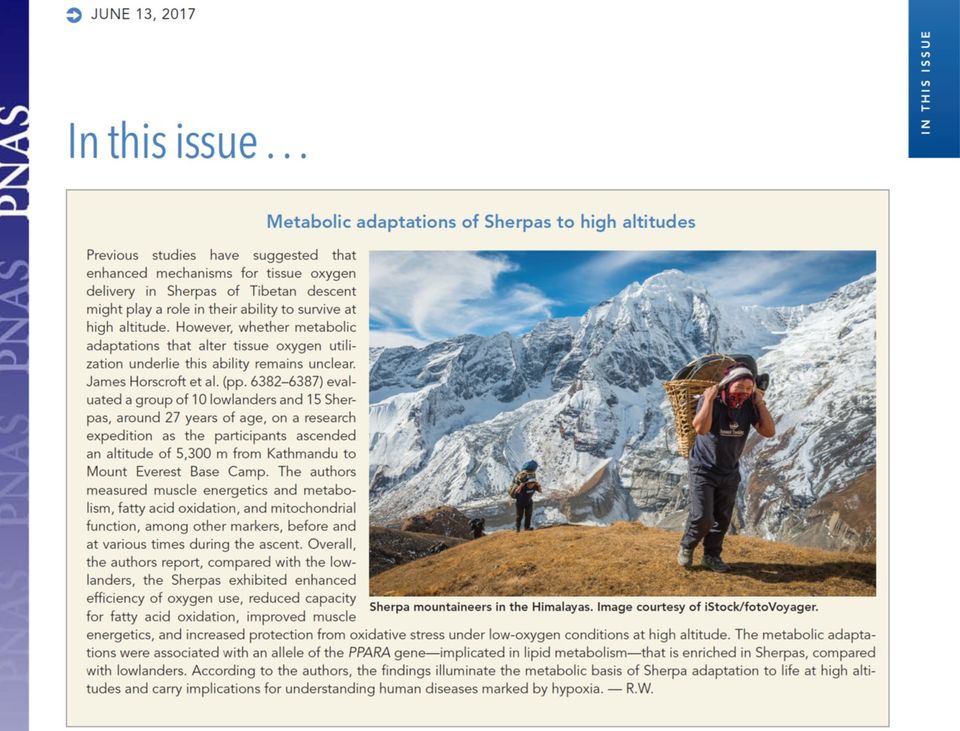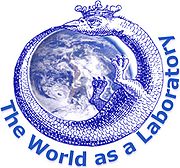Difference between revisions of "Horscroft 2017 Proc Natl Acad Sci U S A"
Beno Marija (talk | contribs) |
|||
| (6 intermediate revisions by 3 users not shown) | |||
| Line 1: | Line 1: | ||
{{Publication | {{Publication | ||
|title=Horscroft JA, Kotwica AO, Laner V, West JA, Hennis PJ, Levett DZH, Howard DJ, Fernandez BO, Burgess SL, Ament Z, Gilbert-Kawai ET, Vercueil A, Landis BD, Mitchell K, Mythen MG, Branco C, Johnson RS, Feelisch M, Montgomery HE, Griffin JL, Grocott MPW, Gnaiger E, Martin DS, Murray AJ (2017) Metabolic basis to Sherpa altitude adaptation. Proc Natl Acad Sci U S A 114:6382–7. | |title=Horscroft JA, Kotwica AO, Laner V, West JA, Hennis PJ, Levett DZH, Howard DJ, Fernandez BO, Burgess SL, Ament Z, Gilbert-Kawai ET, Vercueil A, Landis BD, Mitchell K, Mythen MG, Branco C, Johnson RS, Feelisch M, Montgomery HE, Griffin JL, Grocott MPW, Gnaiger E, Martin DS, Murray AJ (2017) Metabolic basis to Sherpa altitude adaptation. Proc Natl Acad Sci U S A 114:6382–7. https://doi.org/10.1073/pnas.1700527114 | ||
|info=[ | |info=[https://pubmed.ncbi.nlm.nih.gov/28533386/ PMID: 28533386 Open Access], [http://www.pnas.org/content/suppl/2017/05/16/1700527114.DCSupplemental/pnas.201700527SI.pdf#nameddest=ST3 Supporting information] »[[File:O2k-brief.png|36px|link=http://wiki.oroboros.at/images/3/3b/Horscroft_2017_Proc_Natl_Acad_Sci_U_S_A.pdf|O2k-brief]] | ||
|authors=Horscroft JA, Kotwica AO, Laner | |authors=Horscroft JA, Kotwica AO, Laner Verena, West JA, Hennis PJ, Levett DZH, Howard DJ, Fernandez BO, Burgess SL, Ament Z, Gilbert-Kawai ET, Vercueil A, Landis BD, Mitchell K, Mythen MG, Branco C, Johnson RS, Feelisch M, Montgomery HE, Griffin JL, Grocott MPW, Gnaiger Erich, Martin DS, Murray AJ | ||
|year=2017 | |year=2017 | ||
|journal=Proc Natl Acad Sci U S A | |journal=Proc Natl Acad Sci U S A | ||
|abstract=The Himalayan Sherpas, a human population of Tibetan descent, are highly adapted to life in the hypobaric hypoxia of high altitude. Mechanisms involving enhanced tissue oxygen delivery in comparison to Lowlander populations have been postulated to play a role in such adaptation. Whether differences in tissue oxygen utilization (i.e., metabolic adaptation) underpin this adaptation is not known, however. We sought to address this issue, applying parallel molecular, biochemical, physiological, and genetic approaches to the study of Sherpas and native Lowlanders, studied before and during exposure to hypobaric hypoxia on a gradual ascent to Mount Everest Base Camp (5,300 m). Compared with Lowlanders, Sherpas demonstrated a lower capacity for fatty acid oxidation in skeletal muscle biopsies, along with enhanced efficiency of oxygen utilization, improved muscle energetics, and protection against oxidative stress. This adaptation appeared to be related, in part, to a putatively advantageous allele for the peroxisome proliferator-activated receptor A (PPARA) gene, which was enriched in the Sherpas compared with the Lowlanders. Our findings suggest that metabolic adaptations underpin human evolution to life at high altitude, and could have an impact upon our understanding of human diseases in which hypoxia is a feature. | |abstract=The Himalayan Sherpas, a human population of Tibetan descent, are highly adapted to life in the hypobaric hypoxia of high altitude. Mechanisms involving enhanced tissue oxygen delivery in comparison to Lowlander populations have been postulated to play a role in such adaptation. Whether differences in tissue oxygen utilization (i.e., metabolic adaptation) underpin this adaptation is not known, however. We sought to address this issue, applying parallel molecular, biochemical, physiological, and genetic approaches to the study of Sherpas and native Lowlanders, studied before and during exposure to hypobaric hypoxia on a gradual ascent to Mount Everest Base Camp (5,300 m). Compared with Lowlanders, Sherpas demonstrated a lower capacity for fatty acid oxidation in skeletal muscle biopsies, along with enhanced efficiency of oxygen utilization, improved muscle energetics, and protection against oxidative stress. This adaptation appeared to be related, in part, to a putatively advantageous allele for the peroxisome proliferator-activated receptor A (PPARA) gene, which was enriched in the Sherpas compared with the Lowlanders. Our findings suggest that metabolic adaptations underpin human evolution to life at high altitude, and could have an impact upon our understanding of human diseases in which hypoxia is a feature. | ||
<br><br> | |||
|keywords=Metabolism, Altitude, Skeletal muscle, Hypoxia, Mitochondria | |keywords=Metabolism, Altitude, Skeletal muscle, Hypoxia, Mitochondria | ||
|editor=[[Kandolf G]], [[Gnaiger E]], | |editor=[[Kandolf G]], [[Gnaiger E]], | ||
|mipnetlab=AT Innsbruck Oroboros, AT Innsbruck Gnaiger E, UK Cambridge Murray AJ, UK London Martin DS, UK Southampton Grocott MPW | |mipnetlab=AT Innsbruck Oroboros, AT Innsbruck Gnaiger E, UK Cambridge Murray AJ, UK London Martin DS, UK Southampton Grocott MPW | ||
}} | }} | ||
[[File:O2k-brief.png|36px|left]] | |||
== O2k-brief == | |||
| | ::::» [[O2k-brief |List of O2k-Publications presented as O2k-brief]] | ||
| | |||
| | |||
[[File:PNAS in this issue Sherpa.jpg|960px]] | [[File:PNAS in this issue Sherpa.jpg|960px]] | ||
| Line 29: | Line 22: | ||
== Correction == | == Correction == | ||
[[Image:j--P.jpg|50px|left|OXPHOS coupling efficiency]] | [[Image:j--P.jpg|50px|left|OXPHOS-coupling efficiency]] | ||
::::* [http://www.pnas.org/content/suppl/2017/05/16/1700527114.DCSupplemental/pnas.201700527SI.pdf#nameddest=ST3 Supporting information], p 2: ''j ≈ P'' should be changed to ''j<sub>≈P</sub>'' | ::::* [http://www.pnas.org/content/suppl/2017/05/16/1700527114.DCSupplemental/pnas.201700527SI.pdf#nameddest=ST3 Supporting information], p 2: ''j ≈ P'' should be changed to ''j<sub>≈P</sub>'' | ||
:::::::: ''j<sub>≈P</sub>'' = (''P-L'')/''P'' = [[OXPHOS coupling efficiency]] | :::::::: ''j<sub>≈P</sub>'' = (''P-L'')/''P'' = [[OXPHOS-coupling efficiency]] | ||
== Xtreme Everest 2 == | == Xtreme Everest 2 == | ||
| Line 43: | Line 36: | ||
::::* [https://www.youtube.com/watch?v=QG7j_oue2_w How Sherpas have evolved ‘superhuman’ energy efficiency] | ::::* [https://www.youtube.com/watch?v=QG7j_oue2_w How Sherpas have evolved ‘superhuman’ energy efficiency] | ||
== Cited by == | |||
::* 62 articles in PubMed (2021-12-27) https://pubmed.ncbi.nlm.nih.gov/28533386/ | |||
== | {{Labeling | ||
|area=Respiration, mtDNA;mt-genetics, nDNA;cell genetics, Comparative MiP;environmental MiP, Exercise physiology;nutrition;life style | |||
|injuries=Oxidative stress;RONS, Hypoxia | |||
|organism=Human | |||
|tissues=Skeletal muscle | |||
|preparations=Permeabilized tissue | |||
|enzymes=TCA cycle and matrix dehydrogenases, Uncoupling protein | |||
|topics=Coupling efficiency;uncoupling | |||
|couplingstates=LEAK, OXPHOS, ET | |||
|pathways=F, N, S, NS, Other combinations | |||
|instruments=Oxygraph-2k | |||
|additional=2017-05, O2k-brief | |||
}} | |||
Latest revision as of 22:24, 1 June 2022
| Horscroft JA, Kotwica AO, Laner V, West JA, Hennis PJ, Levett DZH, Howard DJ, Fernandez BO, Burgess SL, Ament Z, Gilbert-Kawai ET, Vercueil A, Landis BD, Mitchell K, Mythen MG, Branco C, Johnson RS, Feelisch M, Montgomery HE, Griffin JL, Grocott MPW, Gnaiger E, Martin DS, Murray AJ (2017) Metabolic basis to Sherpa altitude adaptation. Proc Natl Acad Sci U S A 114:6382–7. https://doi.org/10.1073/pnas.1700527114 |
» PMID: 28533386 Open Access, Supporting information »![]()
Horscroft JA, Kotwica AO, Laner Verena, West JA, Hennis PJ, Levett DZH, Howard DJ, Fernandez BO, Burgess SL, Ament Z, Gilbert-Kawai ET, Vercueil A, Landis BD, Mitchell K, Mythen MG, Branco C, Johnson RS, Feelisch M, Montgomery HE, Griffin JL, Grocott MPW, Gnaiger Erich, Martin DS, Murray AJ (2017) Proc Natl Acad Sci U S A
Abstract: The Himalayan Sherpas, a human population of Tibetan descent, are highly adapted to life in the hypobaric hypoxia of high altitude. Mechanisms involving enhanced tissue oxygen delivery in comparison to Lowlander populations have been postulated to play a role in such adaptation. Whether differences in tissue oxygen utilization (i.e., metabolic adaptation) underpin this adaptation is not known, however. We sought to address this issue, applying parallel molecular, biochemical, physiological, and genetic approaches to the study of Sherpas and native Lowlanders, studied before and during exposure to hypobaric hypoxia on a gradual ascent to Mount Everest Base Camp (5,300 m). Compared with Lowlanders, Sherpas demonstrated a lower capacity for fatty acid oxidation in skeletal muscle biopsies, along with enhanced efficiency of oxygen utilization, improved muscle energetics, and protection against oxidative stress. This adaptation appeared to be related, in part, to a putatively advantageous allele for the peroxisome proliferator-activated receptor A (PPARA) gene, which was enriched in the Sherpas compared with the Lowlanders. Our findings suggest that metabolic adaptations underpin human evolution to life at high altitude, and could have an impact upon our understanding of human diseases in which hypoxia is a feature.
• Keywords: Metabolism, Altitude, Skeletal muscle, Hypoxia, Mitochondria
• Bioblast editor: Kandolf G, Gnaiger E
• O2k-Network Lab: AT Innsbruck Oroboros, AT Innsbruck Gnaiger E, UK Cambridge Murray AJ, UK London Martin DS, UK Southampton Grocott MPW
O2k-brief
- '.. it is one of the articles featured on the cover this week, and we also get top-billing in "This Week in PNAS" .. it has been brought to my attention that it was the 13th most read article in PNAS in May - not bad going for an article published on 22nd of the month.' - Andrew Murray, University Senior Lecturer in Physiology, University of Cambridge, UK
Correction
- Supporting information, p 2: j ≈ P should be changed to j≈P
- j≈P = (P-L)/P = OXPHOS-coupling efficiency
Xtreme Everest 2
Relevant links
- Neuer Antrieb für die höhen- und intensivmedizinische Forschung - Medical University of Innsbruck - mypoint, 2017-05-24
- Himalayan powerhouses how sherpas have evolved superhuman energy efficiency
- Lean-burn physiology gives Sherpas peak-performance
- How Sherpas have evolved ‘superhuman’ energy efficiency
Cited by
- 62 articles in PubMed (2021-12-27) https://pubmed.ncbi.nlm.nih.gov/28533386/
Labels: MiParea: Respiration, mtDNA;mt-genetics, nDNA;cell genetics, Comparative MiP;environmental MiP, Exercise physiology;nutrition;life style
Stress:Oxidative stress;RONS, Hypoxia Organism: Human Tissue;cell: Skeletal muscle Preparation: Permeabilized tissue Enzyme: TCA cycle and matrix dehydrogenases, Uncoupling protein Regulation: Coupling efficiency;uncoupling Coupling state: LEAK, OXPHOS, ET Pathway: F, N, S, NS, Other combinations HRR: Oxygraph-2k
2017-05, O2k-brief


